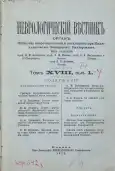Том XVIII, № 1 (1911)
- Год: 1911
- Выпуск опубликован: 15.01.1911
- Статей: 21
- URL: https://journals.eco-vector.com/1027-4898/issue/view/3840
Весь выпуск
Статьи
Координаторно-двигательная функція червя мозжечка
Аннотация
Вся литература, касающаяся общей функціи мозжечка, можетъ быть раздѣлена по своему содержанію на три главныя группы. Къ первой группѣ будутъ относиться тѣ авторы, которые признаютъ за мозжечкомъ исключительную двигательную функцію, отрицая координаторную; къ другой, наоборотъ, слѣдуетъ причислить тѣхъ авторовъ, которые приписываютъ мозжечку координаторную роль, отрицая двигательную; къ третьей, наконецъ, тѣхъ авторовъ, которые допускаютъ оба вида мозжечковаго вліянія, какъ координаторнаго такъ и моторнаго.
 1-28
1-28


Случай хронической прогрессивной хореи
Аннотация
Больной Т., котораго имѣю честь представить Обществу, страдаетъ той формой заболѣванія, которая по типической картинѣ можетъ быть опрѣделена, какъ chorea chronica progressiva. Первымъ выдѣлившимъ хроническую прогрессивную хорею, какъ отдѣльную нозологическую единицу, былъ американскій невропатологъ Huntington, въ честь котораго хроническая хорея долгое время носила названіе „Huntington’овской хореи“, въ отличіе отъ chorea minor, описанной впервые Sydenham’омъ; послѣдняя является болѣе обычной формой Виттовой псяски и носитъ на себѣ всѣ признаки остраго инфекціоннаго заболѣванія.
 29-39
29-39


Опытъ лѣченія воспаленій сѣдалищнаго нерва(ischias) впрыскиваніями охлажденнаго солевогораствора
Аннотация
Не представляя непосредственной опасности для жизни, различнаго рода невралгіи, часто достигающія чрезвычайно сильной степени развитія, по тяжести своего основного симптома, боли, относятся къ числу весьма тяжелыхъ и трудно переносимыхъ больными страданій. Еще тяжелѣе бываетъ самочувствіе больного, когда дѣло идетъ не о невралгическихъ боляхъ, характеризующихся приступами острыхъ болей, смѣняющихся свѣтлыми промежутками, а о боляхъ, продолжающихся непрерывно, имѣющихъ въ своей основѣ болѣе стойкій анатомическій процессъ, о боляхъ невритическихъ.
 40-91
40-91


Матеріалы по вопросу объ умственномъ утомленіи учащихся
Аннотация
Въ 1907 году въ Казанскомъ Коммерческомъ училищѣ преподавателями во главѣ съ директоромъ А. I. Немировскимъ были поставлены опыты. имѣвшіе цѣлью выяснить психическую утомляемость учащихся въ теченіе недѣли. По предложенію проф. В. П. Осипова былъ примѣненъ способъ, изложенный въ „инструкціи къ производству школьнаго психологическаго опыта № 1“, выработанной А. П. Нечаевымъ при участіи членовъ Русскаго Общества нормальной и патологической психологіи.
 92-109
92-109


 110-127
110-127


 128-176
128-176


Къ клиникѣ „epilepsiae gastricae“
Аннотация
Среди разнообразныхъ формъ эпилептическаго діатеза выдѣляется клиническая группа случаевъ эпилепсіи, которую часть авторовъ называетъ epilepsia gastrica. Генезъ и даже этіологія этой группы туманенъ и только клиническая картина эпилепсіи заставляетъ согласиться на временное выдѣленіе этихъ случаевъ въ группу epilepsia gastrica.
 177-184
177-184


Сравнительная анатомія. К. Brodmann. Ученіе о сравнительной локализаціи въ корѣ большого мозга, представленное на основаніи строенія клѣтокъ.
Аннотация
Даннымъ трудомъ авторъ знакомитъ ученаго читателя съ плодами своей восьмилѣтней работы. Конечной цѣлью трудовъ автора было основаніе сравнительной органологіи поверхности большого мозга какою ее признавалъ Th. Meynert, т. е. обоснованною на анатомическихъ признакахъ.
 185-200
185-200


 200-201
200-201


Прив.-доц. Преображенскій. Объ остромъ энцефалитѣ. Мед. обозр. 1910, № 21.
Аннотация
Въ современныхъ работахъ или совсѣмъ не упоминается о существованіи остраго (негеморрагическаго) энцефалита, или о немъ упоминается вскользь, какъ о чѣмъ-то малоизвѣстномъ, сомнительномъ, а иногда какъ о вторичномъ процессѣ при различнаго рода воспаленіяхъ мягкой оболочки.
 201-201
201-201


К. М. Танашевъ. Парадоксальныя движенія верхняго вѣка при параличѣ глазодвигательнаго нерва (симптомъ PseudoGraefe).Труды и проток. Имп. Кавк. общ. апрѣль—октябрь 1910.
Аннотация
Симптомъ Graefe заключается въ томъ, что вѣко опускается неудовлетворительно при опусканіи взора, иногда даже наблюдается при этомъ судорожное, продолжающееся моментъ, движеніе кверху, при поднятіи же взора, поднимается преувеличенно энергично.
 201-201
201-201


Пирадовъ. Къ вопросу о современномъ ученіи о Базедовой болѣзни и ея леченіи. Труды и проток. И. Кавказ. м. общ. февраль—апрѣль 1910 г.
Аннотация
Изложивъ вкратцѣ исторію ученія о происхожденіи, сущности и леченіи morb. Basedowi, авторъ на основаніи литературныхъ данныхъ и собственнаго опыта приходитъ къ выводу, что сущность болѣзни заключается въ гиперсекреціи железы (гипертиреоидизаціи) и леченіе ея должно сводиться къ нейтрализаціи избытка секрета.
 202-202
202-202


 202-202
202-202


Прив.-доц. Л. М. Пуссепъ. Оперативное леченіе травматической афазіи. Хирург. архивъ кн. ІV-я, 1910 г.
Аннотация
Описаны два случая травматической афазіи, при которыхъ операція дала хорошіе результаты. Одинъ—на почвѣ огнестрѣльной рапы безъ поврежденія кости: здѣсь афазія обусловливалась кистой, давившей на центръ Broca; другой обусловливался раздробленіемъ кости съ внѣдреніемъ осколковъ.
 203-203
203-203


 203-203
203-203


 204-204
204-204


Проф. Лапинскій. Значеніе гиперэміи въ леченіи параличей нейритическаго происхожденія.—Русск. Врачъ 1910, № 48.
Аннотация
Авторомъ приводятся шесть исторій больныхъ съ параличами нейритическаго происхожденія хроническаго характера, гдѣ примѣнялось раньше общепринятое леченіе, недавшее никакого результата. Этіологія пользованныхъ авторомъ случаевъ самая разнообразная: отравленіе мышьякомъ, злоупотребленіе алкоголемъ, дифтерія и др.
 204-204
204-204


Хроника и смѣсь
Аннотация
3-го марта 1911 г. Общее засѣданіе Государственной Думы разрѣшило кредитъ на постройку психіатрической клиники на 50 кроватей при Императорскомъ Казанскомъ Университетѣ. — При Психо-Неврологическомъ Институтѣ въ Петербургѣ учреждена психіатрическая секція.
 205-208
205-208


Протоколъ VI засѣданія Общества невропатологовъ и психіатровъ при Императорскомъ Казанскомъ Университетѣ 21 октября 1910 г.
Аннотация
Присутствовали: профф.: Л. О. Даркшевичъ, В. П. Осиповъ, д-ра: В. И. Левчаткинъ, В. Н. Осипова, В. П. Первушинъ, I. А., Веселигскій, П. С. Скуридинъ, Н. А. Донсковъ, А. С. Шоломовичъ, гости, д-ра: Воскресенскій, Баклушинскій, Лапухинъ, Архангельская, Яхонтовъ, Енохинъ, Лопатинъ, Протопоповъ, Эмдинъ и нѣск. десятковъ студентовъ медиковъ.
 208-212
208-212


Протоколъ VІII-го засѣданія Общества невропатологовъ и психіатровъ при Императорскомъ Казанскомъ Университетѣ 30-го ноября 1910 года.
Аннотация
Предсѣдательствовалъ проф. Л. О. Даркшевичъ при секретарѣ Ворошиловѣ. Присутствовали: проф. Осиповъ; д-ра Первушинъ, Ѳаворскій, Веселитскій, Клячкинъ, Левчаткинъ, Донсковъ, Пипкинъ, Головинъ, Эмдинъ, Протопоповъ, Лапухинъ, Скуридинъ, Архангельская, Семилейская, Лопатинъ, Николаевскій и др., студентовъ человѣкъ 40.
 212-217
212-217


Протоколъ ІХ-го засѣданія Общества невропатологовъ и психіатровъ при Императорскомъ Казанскомъ Университетѣ 17 декабря 1910 года.
Аннотация
Предсѣдательствовалъ проф. Л. О. Даркшевичъ при секретарѣ Ворошиловѣ. Присутствовали: проф. Миславскій, проф. Осиповъ, д-ра: Первушинъ, Ѳаворскій, Горяевъ, Вишневскій, Веселитскій, Головинъ, Жилинъ, Эмдинъ, Лапухинъ, Николаевскій, Донсковъ Н. А., Донсковъ В. А., Клячкинъ, Баклушинскій, Бѣлицкій, Поповъ, Чебоксаровъ, Шоломовичъ и человѣкъ 20 студентовъ.
 217-223
217-223











